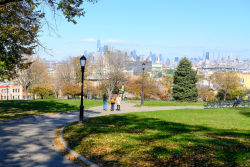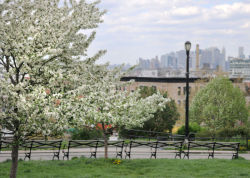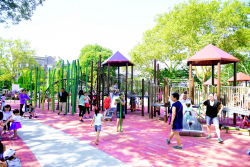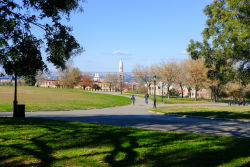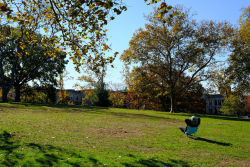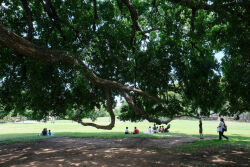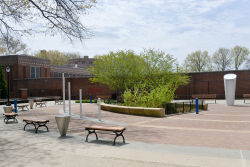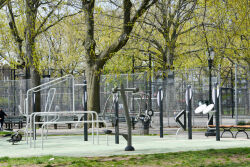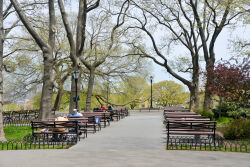Sunset Park
Shellfish in New York City - Sunset Park
Sunset Park in Brooklyn affords a thrilling view of New York Harbor. At one time, the waters of this area were filled with boats attempting to harvest shellfish. Today, such boats are a rare sight in the harbor. As New York’s population grew, so did the amount of human waste and industrial pollution being discharged into the City’s waters. Critical wildlife habitat was rapidly destroyed for industrial and residential development, and remaining shellfish habitats were harvested beyond their capacity. The once-thriving New York shellfish industry came to an abrupt end as a result of human influence, and today, people are forbidden to eat any shellfish taken from New York Harbor.
Many species of shellfish inhabit New York Harbor, such as oysters, mussels, and clams. The hard-shell clam (Mercenaria mercenaria), also called the quahog, was originally sacred to many Native Americans, who made currency (wampum) by cutting beads out of the purple lining of its shells. The clam lives in sandy-bottomed bays stretching from Canada to Texas. The American oyster (Crassostrea virginica) has a rough and irregular shell. Native Americans thought so highly of the oyster that they brought some to the first Thanksgiving along with wild turkeys. It attaches to a hard surface when it is young and remains immobile for the rest of its life. In contrast, the bay scallop (Aequipecten irradians), after a brief juvenile stage attached to eelgrass (Zostera marina), moves around the seafloor using its siphon for jet propulsion. Ribbed mussels (Geukensia demissa) dominate intertidal salt marshes, growing among the blades of salt marsh cordgrass (Spartina alterniflora). Blue mussels, however, grow on the rocky shores of Pelham Bay Park.
Despite the wide diversity in species size, shape, and behavior, all shellfish share several habitat needs. An appropriate substrate, or growing medium, must be present for the shellfish to adhere to. As filter feeders, shellfish are particularly susceptible to sediment, bacteria and toxic chemicals found in the water. The filtering action of shellfish helps to remove pollutants from the water and maintain the health of the harbor ecosystem. High levels of sediment in stormwater, caused by erosion and urban runoff, can impair feeding, as the shellfish spend too much energy separating sediment particles from food. Low levels of oxygen, which occur when large nutrient inputs (from lawn fertilizers and human waste in combined sewer overflows, for example) cause explosions in algae populations, can also pose a threat to the survival of shellfish. Shellfish are further threatened by bacteria, pesticides, and metals, and their populations have declined recently due to the human-caused stresses to their environment.
In the 19th century, New York City shipped shellfish all over the world. Oysters and clams became some of the City’s biggest exports, with clam boats filling Little Neck Bay in Queens and Prince’s Bay in Staten Island. People all over the world enjoyed raw New York City oysters with lemon. However, in 1916 several cases of typhoid fever were traced to oysters taken from New York Harbor. This led the city Board of Health to condemn the oyster beds. The harbor, which was seen by many as an open sewer and garbage dump, became too polluted for the oysters it contained to be eaten. Although shellfish thrive on the floor of the harbor and pollution inputs have been decreased, persisting contaminants from decades past remain in the shellfish tissue, making them unsafe to eat.
Check out your park's Vital Signs
Clean & Safe
Green & Resilient
Empowered & Engaged Users
Share your feedback or learn more about how this park is part of a
Vital Park System

Know Before You Go

Contacts
General Inquiries: (718) 965-6533

